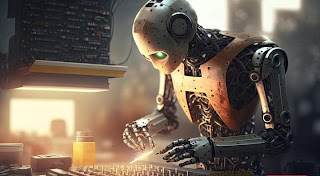“AI has created molecular structures of 2.2 million artificial substances”
In 1828, the German chemist Friedrich Voller made the first completely synthetic compound or artificial substance. He synthesized urea in the laboratory, which until then could only be found in nature.
At present, urea is used as a fertilizer for agriculture. In addition, large quantities of urea are required in industries ranging from livestock feed to pharmaceuticals and plastics manufacturing.
Ever since Vollar’s discovery, inventors and scientists around the world have been creating other substances artificially.
In 1907, Belgian chemist Leo Hendrik Backeland made plastic completely artificially. For this reason, he is called the father of plastic industry.
Nylon was invented as the first synthetic fiber in 1935, which later changed the image of the clothing industry.
Today several industries are based on completely synthetic materials. Everything from fuel oil, lubricants, diamonds, diapers, rubber or medicine is made entirely from synthetic materials. Thus, there are numerous artificial compounds that we use every day.
Meanwhile, almost 200 years have passed since the discovery of the first artificial substance in history. In this, many artificial substances have been invented by the efforts of researchers, inventors and scientists to meet the needs of people. However, behind each substance invention, researchers need years of time, a lot of labor is needed.
But now AI is inventing synthetic materials without human help. Especially in this case, the organization ‘DeepMind’ acquired by Google has brought a revolutionary change.
DeepMind was founded in 2010 by Demi Hassabis and Mustafa Suleiman, two British researchers, and Shane Legg, a New Zealand researcher. The company mainly deals with artificial intelligence or AI.
In 2014, the company was acquired by Google, which is now known as ‘Google DeepMind’. The London-based company currently has research centers in Canada, France, Germany and the US.
Recently, DeepMind’s AI has succeeded in inventing the molecular structures of millions of synthetic materials under a new project called ‘GNOME’ (GNoME). It is not possible for researchers or scientists to invent new substances at such a fast pace.
Also, using the information related to the molecular structure of these potential substances, the American “Berkeley Lab” is making an average of two substances in the lab every day.
It usually takes researchers months or even years to develop a new substance. DeepMind is going to bring a dramatic change to this image.
Yesterday (November 29, 2023), their research paper was published in the ‘Nature’ journal.
Fully Automated Synthetic Materials Invention And Fabrication In The Lab
DeepMind’s new project is called ‘GNOME’, which stands for ‘Graphical Networks for Material Exploration’. Under this project, AI has already generated the molecular structures of 2.2 million potential new synthetic substances.
More than 700 synthetic substances have already been created in the lab based on those molecular structures. DeepMind is currently researching the efficacy and potential uses of these substances.
DeepMind reported their success in the Nov. 29 issue of the journal Nature.
In the same issue of the journal, another American laboratory separately announced their success in the automated production of synthetic materials.
Lawrence Berkeley National Laboratory located in California is popularly known as Berkeley Lab. They collect information from databases of potential synthetics. This database also contains material invented by DeepMind.
The laboratory is using machine learning and robotics to build artificial materials without human assistance. They have built a new laboratory for this work, which is named ‘A-Lab’.
From this recent progress, it can be assumed that AI will make a major contribution in the near future in the discovery of new substances or materials.
That Is Why People Take A Lot Of Time To Invent New Substances Or Materials
Artificial substances play an important role in any technology. However, in order to create a new substance, scientists try to combine more than one substance among 118 basic substances.
However, the number of substances that can be created artificially by adding several basic substances together is countless. Finding out among the countless possible substances that can be used in real life is a big challenge for scientists.
That is why researchers and scientists usually make small changes in the structure of existing substances to invent new substances. However, scientists also need a lot of time to do this work. It usually takes months to years for a research team to develop an effective substance.
Besides, researching existing substances reduces the possibility of discovering unexpected and completely new substances.
How New Materials Are Being Invented With The Help Of AI
Before DeepMind’s research began, we had less than 100,000 synthetic materials.
But only with the help of DeepMind’s new project, we now know the molecular structure of more than 421,000 artificial substances for sure.
But how does DeepMind’s AI work?
DeepMind mainly uses two ‘deep learning models’ to invent new materials. Simply put, deep learning is an AI-based machine learning method. And overall, a significant branch of AI technology is machine learning.
However, one of DeepMind’s two deep learning models works similarly to human researchers. That is, by making small changes in existing substances, the molecular structure of possible new synthetic substances is created. But AI does this much faster than humans.
In a very short time, the first deep learning model inferred the molecular structure of more than 1 billion substances.
Meanwhile, the second deep learning model does not work with existing compounds. Rather, based on the chemical formula, it makes assumptions or ideas about what kind of compound can be formed when multiple basic substances are added together. And based on that idea, testing how effectively a compound can be used in the real world.
From the results generated by the two deep learning models, the AI determines which substances will be stable in the real world. That is, potential new materials that are fragile or unable to hold their own structure are excluded.
The substances that survive are then validated again in the same manner by deep learning models. After doing this several times, the substances that finally survive are tested by human researchers.
Finally selected substances are recognized as new synthetic substances.
Attempts to find the structure of new materials with the help of AI have been made before. Under a project called ‘The Materials Project’ at Berkeley Lab, hundreds of thousands of new materials have already been invented and stronger structures of existing materials have been developed.
In all, 48,000 materials were worked on under the Materials Project. However, the scope of DeepMind’s ‘GNOME’ project is much larger than that project. A large amount of data or information is being worked on in the project. In this the structure of millions of new substances is unfolding before us in a very short period of time.
These New Materials Can Be Used In The Real World
Berkeley Lab is currently making many substances in the lab in a fully automated manner based on AI-invented molecular structures. This is being done automatically, with the help of AI.
Their ‘A-Lab’ worked on 58 substances in 17 days, out of which they succeeded in making 41 substances.
Robot and machine learning based ‘A-Lab’ had to try 355 times to make these 41 substances.
That is, Berkeley Lab’s AI succeeds by finding the cause of that failure after failing many times.
That is, it can be confirmed that the new substances invented by DeepMind’s AI can actually be created with the help of successful experiments at Berkeley Lab.
But what will we use these new substances?
These new materials created by AI can be used in numerous technologies such as batteries, solar panels or microchips. These substances will also be useful in the construction of ceramic or electrical devices.
For example, DeepMind’s inventions will greatly contribute to the advancement of lithium-ion battery technology.
Lithium-ion batteries will play a major role in shaping a carbon-free future. Due to their durability, low weight and high capacity to hold energy, this type of battery is currently used in many types of electrical appliances. In the future, this battery will be used to run everything from cars to ships or airplanes with the help of electricity.
At least 528 of the millions of materials DeepMind has discovered could improve lithium-ion batteries.
However, after a new substance is invented, it usually takes decades before it is used in industry or production. DeepMind and Berkeley Lab researchers are trying to bring this time down to 5 years.





